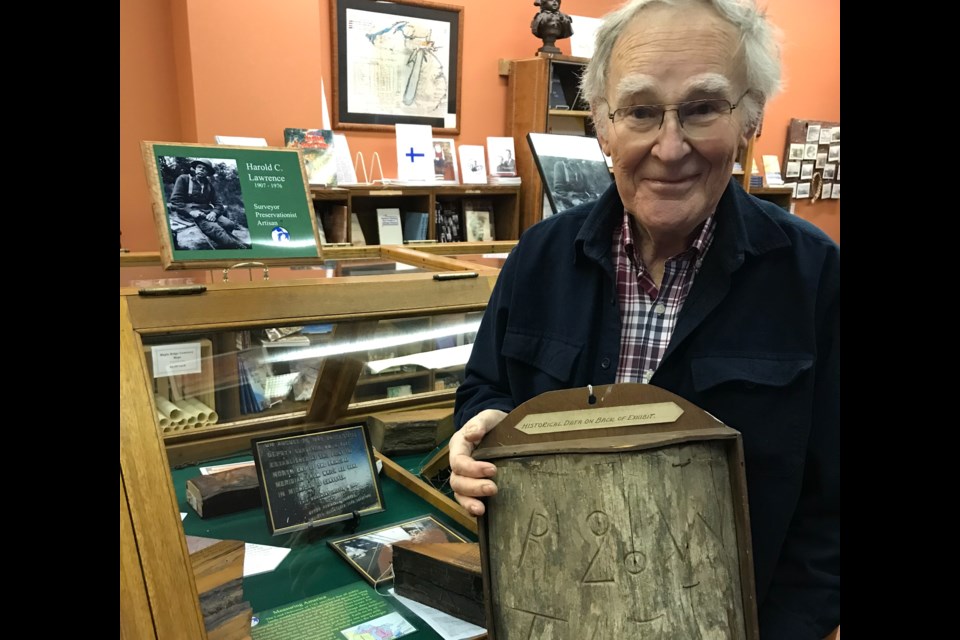The Chippewa County Historical Society is displaying a collection of artifacts that would grab the attention of not only those interested in history, but also land surveying, forestry, and good fortune.
CCHS acquired the Harold C. Lawrence Collection in 2009. It includes more than 50 pieces of trees with old survey markings from the days when Michigan’s Upper Peninsula was first surveyed in the mid-1800s. Lawrence, working as a surveyor for the Newberry Lumber and Chemical Co. in the first half of the 1900s, collected the markers – which he was legally permitted to do, as long as he replaced them with modern markers – and meticulously preserved them and recorded their history and details of his encounters with them.
To the uninitiated, a collection of pieces of trees might sound more like the makings of a bonfire, not a museum display. But the effort Lawrence made to preserve this part of Michigan history is impressive and a testament to hard work, perseverance and forethought.
When surveyors were plotting land boundaries in the days before GPS and permanent metallic disc markers or stakes, they would use an axe to mark property line trees with slashes or notches. Their notes would detail which trees were bearing trees, or corner posts where property lines meet or intersect; witness trees, which told surveyors a bearing tree was nearby; and line trees, which were trees blazed along a property line.
Lawrence encountered many of these trees decades after they were marked. Some barely showed the dimpled slash marks which had been covered with new growth over the years. He used his axe to remove the old survey marks. To preserve them, he sanded the inner portion to smooth it, before writing details of the find on the sample with pen and ink, and then covering it all with shellac or varnish.
“He clearly was thinking that he was going to be making a collection for a museum,” said Bernie Arbic, member of the CCHS board of directors and “photo guy” who was featured in the January 12, 2022 issue of the Soo Leader. “The detail in the collection is remarkable. If it’s not unique, there certainly can’t be many like them in the whole country.”
Along the way to collecting these aged survey marks, Lawrence found other artifacts, including two sawmill logs marked by the companies that were floating them down rivers to sawmills. Logs were marked with the company insignia so they could be sorted when they reached the mills. He found one marked log in Luce County’s Two Hearted River, and another on the Tahquamenon River above the lower Tahquamenon Falls.
Later in life, Lawrence moved to Wisconsin, and the family lost touch with each other. After he died, his northwoods cabin was donated to St. Norbert’s College in Green Bay. The collection was found in the cabin, and when it was discovered that it had ties to the Eastern Upper Peninsula, contact was made with the historical society and River of History Museum to arrange a donation. This is where the good fortune comes in.
Arbic wrote a story about the collection in the July 2011 issue of the CCHS newsletter, “River Soundings.” In a cutline under a picture of Harold Lawrence, he wrote that CCHS had little information about Lawrence and invited readers to fill in the blanks.
In 2016, Harold’s grandson, Bill Lawrence, was doing some internet research on his grandfather and he came across the CCHS article. He made arrangements for his family, including Harold’s son, Tom, 84, to travel to Sault Ste. Marie to meet CCHS staff and be reunited with Harold’s labor of love.
“Tom was quite emotional when he saw those pieces,” Arbic said. “He hadn’t seen them since he was young, and he remembered them being on display in their family’s house and he remembered his father talking to family and friends about them.”
Tom Lawrence and his family provided a generous donation to display the artifacts at the CCHS museum and gift shop at 115 Ashmun St. Check out the organization website for hours of operation and more information -- cchsmi.com



